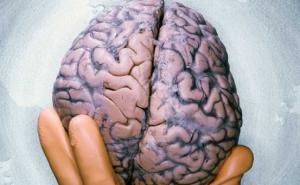据2009年5月8日的《科学》杂志报道说,在电脑前工作几个小时之后,伸展一下手臂及活动一下颈部可能会让人感觉很好。 令人感到惊奇的是,新的研究提示,你所感觉到的并非是身体运动本身。 相反,你的伸展肢体的主观感受可能是由想运动的意愿所产生的,而这种意愿是由与实际运动完全不同的脑部区域所控制的。 一个法国的研究团队根据他们的发现而得出了这一结论。
研究发现,刺激脑部的某一部分会使自愿者有想要活动某些身体部位的冲动,而刺激脑部的另外的部分则会在自愿者不知道的情况下引起身体的运动。 Michel Desmurget及其同僚对与运动相关的两个脑部区域进行了研究,它们是后顶叶皮质和前运动皮质。这些受试的患者都接受过切除脑瘤的脑外科手术。 神经外科医生有时会在局部麻醉的情况下对清醒患者的脑部进行电刺激,这种做法是外科手术准备的一部分,旨在将术后并发症的风险降至最低。
科学家们将他们的试验融入到7位自愿患者的这一手术过程中。 他们发现,刺激后顶叶皮质会使某些患者报告说他们想运动他们的上肢、嘴唇或舌头,尽管它们实际上并没有做这些运动。 如果增加刺激的强度的话则会使患者以为他们实际上做了这些运动或说过话,而实际上他们并没有做过这些运动或说过话。 相反,刺激额叶的前皮质运动区则会刺激患者出现真正的口腔和肢体运动,而患者则没有自觉地发现这些运动。 一则相关的Perspective对这些发现进行了详细的说明,并对为什么由我们自己的“自由意志”所做出的自主动作对现代来说是一种令人感到好奇的谜团进行了讨论。
Science8 May 2009:DOI: 10.1126/science.1169896
Movement Intention After Parietal Cortex Stimulation in Humans
Michel Desmurget,1,2 Karen T. Reilly,1,2 Nathalie Richard,1,2 Alexandru Szathmari,3 Carmine Mottolese,3 Angela Sirigu1,2,*
Parietal and premotor cortex regions are serious contenders for bringing motor intentions and motor responses into awareness. We used electrical stimulation in seven patients undergoing awake brain surgery. Stimulating the right inferior parietal regions triggered a strong intention and desire to move the contralateral hand, arm, or foot, whereas stimulating the left inferior parietal region provoked the intention to move the lips and to talk. When stimulation intensity was increased in parietal areas, participants believed they had really performed these movements, although no electromyographic activity was detected. Stimulation of the premotor region triggered overt mouth and contralateral limb movements. Yet, patients firmly denied that they had moved. Conscious intention and motor awareness thus arise from increased parietal activity before movement execution.
1 Centre de Neuroscience Cognitive, CNRS, UMR 5229, 69500 Bron, France.
2 Université Lyon 1, 69100 Villeurbanne, France.
3 Neurosurgery Unit 500, H?pital Pierre Wertheimer, Hospices Civils de Lyon, 69003 Lyon, France.




